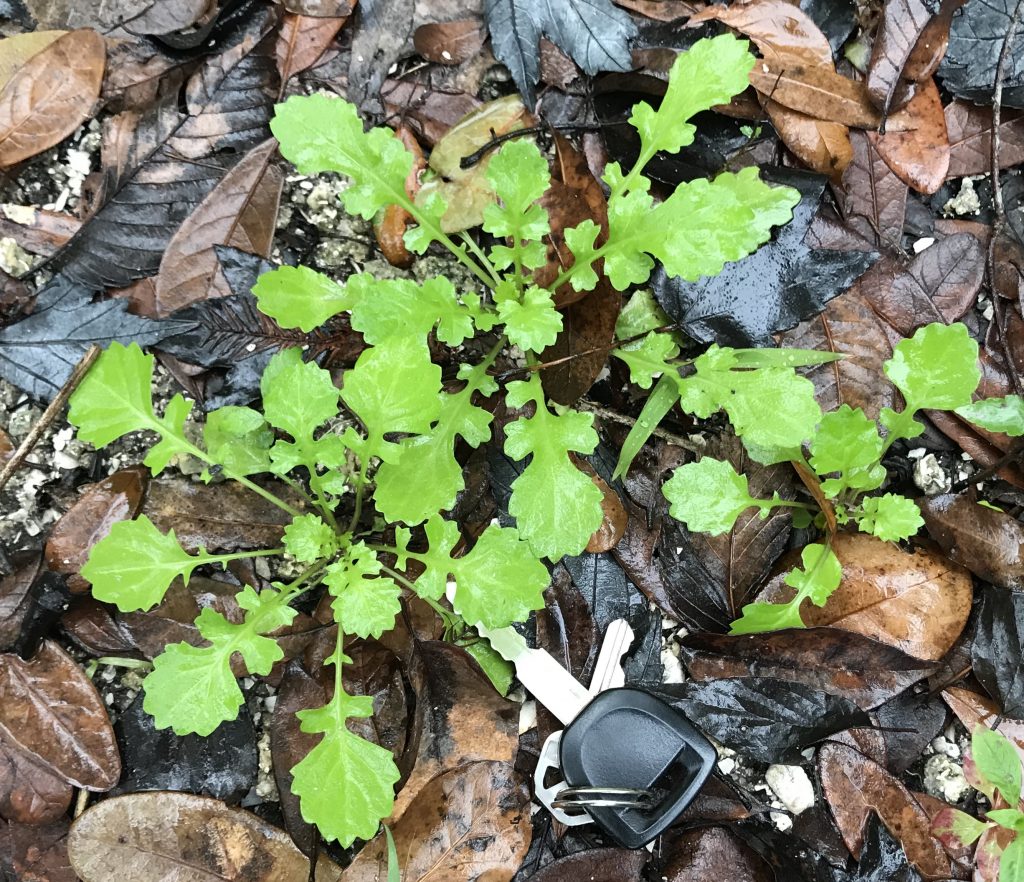
DO NOT EAT: This is toxic butterweed, a young look-alike for mustard. Photo by GreenDeane
It’s a good time to mention the toxic Butterweed (and Rattlebox below.) We saw some young examples of Butterweed in our foraging class at Ft. Mead Sunday. Part of the area we have that class in is along the Peace River and is damp. That is where you find Butterweed. Unfortunately it can resemble young mustards so much so one of its common names is Cressleaf Goundsel. It has two botanical names: The current, Packera glabella, and its former, Senecio glabellus. If you eat Butterweed today it will put you in the hospital today with liver damage. The more you eat the more damage. It is also harmful to livestock. To quote the University of Florida:
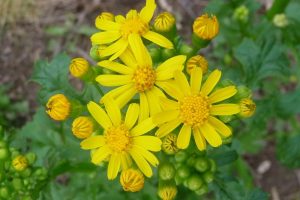
Butterweed can be deadly. Avoid it.
“Butterweed is toxic to both cattle and horses. It is known to cause liver disease in cattle, producing symptoms such as listlessness, decreased appetite, and photosensitization in extreme cases. Horses frequently appear uncoordinated, become entangled in fences, and awkwardly bump into objects after ingesting the plants. Cattle that consumed 4 to 8% of their body weight in green plant over a few days developed acute liver necrosis and died within 1 to 2 days. Cattle that ingested 0.15% of their body weight (fresh weight) of a species in the same genus as butterweed for a minimum of 20 days resulted in 100% mortality. This equates to a 20-day cumulative dose of 2% of an animal’s body weight of dry. It also appears that this species has been responsible for abortions in cattle, making control of butterweed a necessity. “
From a foraging point of view the species does resemble mustard until it blossoms. The flower is totally wrong for a mustard and more resembles a yellow daisy. However, it tends to grow the same time of year and in similar environments. Fortunately, unlike mustards, the leaves are extremely mild in taste so one knows immediately it is not in the mustard clan. Again, do not eat Butterweed. It is toxic. And when harvesting mustards make sure you have a mustard.

Foraging classes are held rain or shine, heat or cold.
One foraging class this weekend because of the holiday. This time in Port Charlotte always an interesting location because of its location along the Peace River and the Gulf.
Saturday December 28th, Bayshore Live Oak Park, Bayshore Drive. Port Charlotte. Meet at the parking lot at the intersection of Bayshore Road and Ganyard Street. 9 a.m. to noon.
Saturday, January 4th, Mead Garden, 1500 S. Denning Dr., Winter Park, FL, Meet by the restrooms. 9 a.m. to noon. (Don’t confuse this with Ft. Meade which is a different location above.)
Sunday, January 5th, Dreher Park, 1200 Southern Blvd., West Palm Beach, 33405. Meet just north of the science center. 9 a.m. to noon.
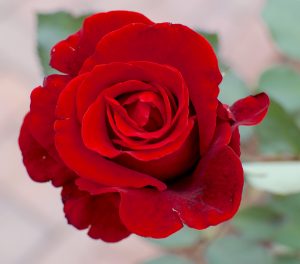
Roses are eaten carefully. Photo by Green Deane
While it seems counter intuitive Roses seem to do well in the southern winter. They don’t like the summer heat and are a challenge to grow here. So this time of year some of them are at their blossoming best. The Rose family is a friendly one to foragers from blossoms such as this one to apples which are related. High in vitamin C, Roses have been used medicinally for about as long as man has been fiddling with medicine. As a side note back in the 90s during my mid-life crisis I decided to go to law school. I was accepted to several and to earn money before classes started I delivered flowers. It was a job with many surprises but one of them was the big, gorgeous roses we delivered for holidays like Valentine’s Day had no scent. They were bred for beauty. We had to spray artificial rose scent on them just before delivery. One also learned very quickly to spray the roses outside of the delivery van or the van and you smelled intensely of roses for several days. To read more about roses go here.
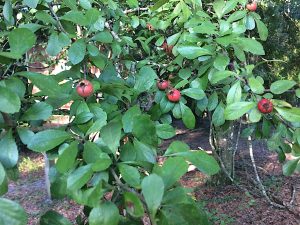
Hawthorns are related to roses. Photo by Green Deane
Hawthorns are in the rose family and barely make it in to Central Florida. However they are common farther north and like many fruit-bearing plants of that clan the seeds are toxic. There was a huge one across the dirt road from our house in southern Maine. It had thorns close to three-inches long and was a favorite nesting place for birds (I presume because bird predators couldn’t get past the thorns easily.) Hawthorn leaves often resemble animal paws and there are sharp thorns even on very young plants. While the berries on most of them can be cooked into jelly (strain out the seeds) there’s one special species worth singling out, Crataegus monogyna. The Dead Latin species name, monogyna, tells you what to expect when you crush the fruit: One seed. This is important. It is the only Hawthorn that can be used to make a jelly without cooking or adding anything else to the mix. You crush the fruit, push the liquid through a strainer and let it set. Takes about five minutes. C. monogyna grows in a lot of places in the United States and is native to Europe. To read more about it go here.
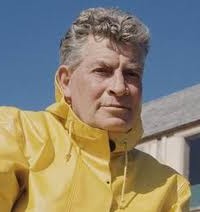
Euell Gibbons had Marfan Syndrome.
Do you remember Euell Gibbons? He was the first foraging TV-personality. Gibbons became rather famous for asking “Ever eat a pine tree?” His book “Stalking The Wild Asparagus” was an instant best seller and he was seen in probably one of the first back-to-nature cereal commercials that pitched the new idea of promoting nutrition. The FCC took it off the air because it said Gibbons was promoting the unacceptable idea that wild food is safe to eat (Oh My! What did we ever do before agriciulture?) Until literally the very end of Euell’s career — he died in 1975 — nutrition had little to do with food unless you had a particularly odd medical condition. Nutrition was some esoteric science dominated by plump matrons. Not today. Nutritionists now all seem young and photogenic and incredibly fit. Nutrition is also why people eat these days. It’s a different industry with a different face than when Euell was around. Is that a good thing? Is there a difference? Is eating for nutrition misguided? For a bit of history and perspective on “nutrition” click here.
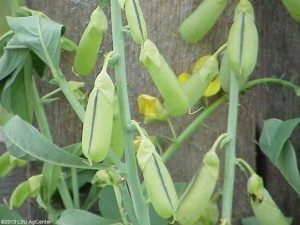
Rattleboxes are toxic.
No, the Rattlebox is not edible. In fact it is quite toxic. The problem is we see it everywhere. Why? One reason is that it was used as a rotational crop until a few decades ago. It was often used in tobacco fields and to fix nitrogen in tung-oil tree orchards. Not only is it toxic to humans but is the source of livestock poisoning as well particularly horses and cows in which it causes liver damage. One to three percent of body weight ingested can be fatal and can accumulate over several days. The seeds and foliage contain pyrrolizidine alkaloids. Liver enzymes convert the alkaloids into toxic pyrroles that can damage liver and lung cells. Worse it can take months for the symptoms to appear when little or nothing can be done about the damage. Similar pyrrolizidines are found in (also non-edible) Dog Fennel and the Florida Tassel Flower. Hardy, Crotalaria seeds can remain viable for 60 years.
Merry Christmas! This is weekly newsletter 385, If you want to subscribe to this free newsletter you can find the sign-up form in the menu at the top of the page.
To donate to the Green Deane Newsletter click here.


Wow! Scary how similar the Butterweed is to False Hawksbeard when young. Thanks for the info!
An interesting related story about Euell Gibbons.
He had a chapter on rose hips in one of his books (as I read them all).
One entry was regarding a Scandinavian soup made with rose hips using wild roses. I collected a bunch of small wild rose hips and made the soup after running them thru a colander and thru cheesecloth and made the soup. I shared it with my sister who was always a willing participant to my wild food concoctions. It tasted good enough, but about 10 mins later, my stomach started rumbling as did my sister’s stomach and we both rushed to the bathrooms due to it’s apparent strong purgative quality! I wrote Euell Gibbons about my experience and his wife Freda Gibbons was kind enough to reply with a letter in which she stated Euell Gibbons just passed and this was some time in 1975 or 1976. She also stated she had some knowledge in wild foods and neither she nor Euell had any knowledge of rose hips purgative qualities and suggested it could have been the seeds!
I’ve had a relationship with Rattlebox for some time now without actually knowing what it was. I first happened upon it on a dirt road in the Tomoka Farms area near Daytona Beach. I thought it was such a pretty plant and took the little seed pods home to North AL to plant in my flower beds. The strange thing was that when I grew them they grew to about four times as tall as the parent plant that I had gotten the seeds from back in FL. Maybe a lot more nitrogen in my soil compared to the sandy soil in FL. I also become familiar with butterweed a few years back when I saw it growing in wet areas. I was able to identify it in my feild guide, but didn’t know that it was so toxic along with the rattlebox. Thanks for sharing the information!